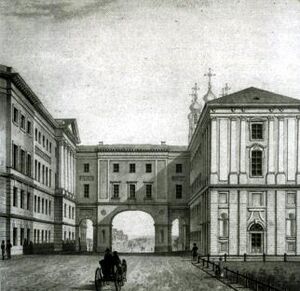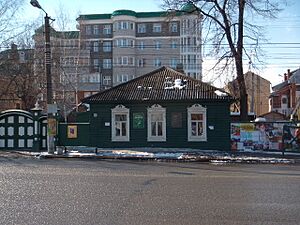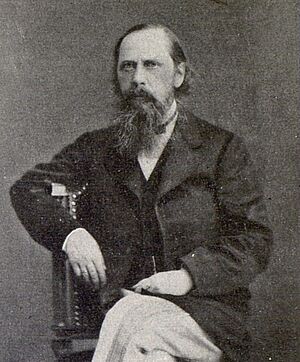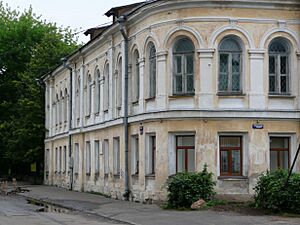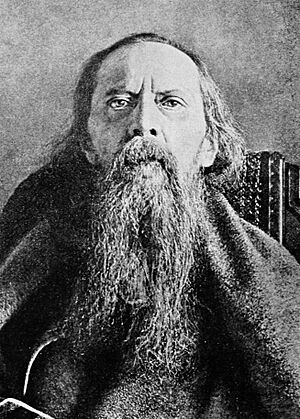Mikhail Saltykov-Shchedrin facts for kids
Quick facts for kids
Mikhail Saltykov-Shchedrin
|
|
|---|---|
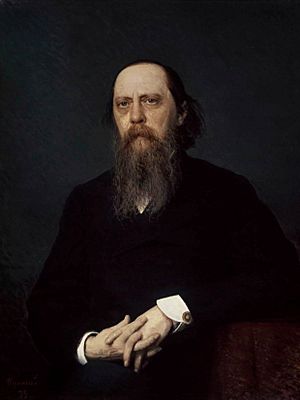
Portrait of Shchedrin by Ivan Kramskoi
|
|
| Born | 27 January 1826 village Spas-Ugol, Kalyazin uyezd, Tver Governorate, Russian Empire |
| Died | 10 May 1889 (aged 63) Saint Petersburg, Russian Empire |
| Pen name | N. Shchedrin, Nikolai Shchedrin |
| Occupation | Novelist, journalist, short story writer, playwright, civil administrator, magazine editor |
| Nationality | Russian |
| Period | 1847—1889 |
| Notable works | The History of a Town The Golovlyov Family Fables |
| Spouse | Elizaveta Boltova |
| Relatives | Saltykov family |
| Signature | |
Mikhail Yevgrafovich Saltykov-Shchedrin (Russian: Михаи́л Евгра́фович Салтыко́в-Щедри́н; 27 January [O.S. 15 January] 1826 – 10 May [O.S. 28 April] 1889) was a very important Russian writer. He was known for his satire, which means he used humor and exaggeration to criticize society.
Mikhail Saltykov-Shchedrin spent most of his life working for the government. He was a civil servant, which is someone who works for the government to help run the country. After a famous poet named Nikolay Nekrasov died, Saltykov-Shchedrin became the editor of a Russian magazine called Otechestvenniye Zapiski. However, the government eventually closed the magazine in 1884.
In his books, Saltykov-Shchedrin was very good at showing real life. He also mixed humor and fantasy into his stories. His most famous books are The Golovlyov Family (about a family's history) and The History of a Town (a political story). These books are important examples of 19th-century fiction. Saltykov-Shchedrin is seen as a major writer in Russian Realism, a style of writing that shows life as it really is.
Contents
Early Life and Family
Mikhail Saltykov was born on January 27, 1826. He was born in a village called Spas-Ugol, which is now in the Moscow Oblast region of Russia. He was one of eight children in a large and important Russian family. His father, Yevgraf Vasilievich Saltykov, came from a very old noble family. A noble family is one that has a high social rank, often with land and power.
Mikhail's mother, Olga Mikhaylovna Saltykova, came from a rich merchant family. Merchants are people who buy and sell goods. Her family had become noble because of a large gift they gave to the army in 1812. When Mikhail was born, his father was 50 years old, and his mother was 25.
Mikhail spent his early childhood on his parents' big estate. An estate is a large area of land with a big house. He remembered that life was hard for people living under serfdom. Serfdom was a system where peasants were tied to the land and had to work for the landowner. He felt that this system made everyone, rich or poor, feel like they had no rights.
Life in his own family was also difficult. His mother was very strict and bossy. She scared the servants and her own children. This family life later inspired his novel The Golovlyov Family. Mikhail felt lonely and uncared for, even though he had some freedom. He also remembered not being allowed to go outside much. He knew animals only from seeing them cooked, not alive. This is why his books often have few descriptions of nature.
School Days and First Writings
Mikhail's early education was not very organized. But he was a very smart boy. By the age of six, he could speak French and German well. A painter who was a serf and a local priest taught him to read and write Russian. He loved to read, and the Gospel (a part of the Bible) was a big influence on him when he was eight.
When he was ten, Saltykov joined a school for noble boys in Moscow. He skipped the first two grades because he was so smart. In 1838, he moved to the Tsarskoye Selo Lyceum in Saint Petersburg. He studied there for six years.
Saltykov started writing poems at the Lyceum. He also translated works by famous poets like Lord Byron and Heinrich Heine. His first poem, "The Lyre," was published in a magazine in 1841. More of his poems appeared in another magazine, Sovremennik, a few years later. He also joined a writing group where he met Vissarion Belinsky, a famous literary critic. Belinsky's ideas greatly influenced Mikhail.
After finishing the Lyceum in 1844, Saltykov got a job in the Ministry of Defense. He had hoped to go to Saint Petersburg State University, so this was a bit disappointing. Around this time, he started reviewing children's books and textbooks for magazines. His reviews were very sharp. He also became interested in Socialism, which are ideas about how society should be fair and equal for everyone. He joined a group called the Petrashevsky circle, which discussed these new ideas.
Working for the Government
In 1847, Saltykov published his first short novel, Contradictions. It was about the difference between good ideals and the harsh reality of life. His next book, A Complicated Affair (1848), was about social unfairness. These books were praised by critics. However, the government saw them as dangerous. After the French Revolution of 1848, the authorities were very worried about new ideas. So, in April 1848, Tsar Nicholas I ordered Saltykov's arrest and sent him away to Vyatka. This was a kind of exile.
In Vyatka, Saltykov worked as a special helper to the governor. His job was to investigate small crimes like bribery and police mistakes. He tried hard to leave Vyatka, but the government kept saying no. He started to think he might have to stay there forever. But the people in Vyatka were kind to him. He was a welcome guest in many homes. He even met his future wife, Elizaveta Boltina, the daughter of the vice-governor.
While in Vyatka, Saltykov also worked on a history textbook for young women. He traveled a lot for his government job, visiting many different regions. This gave him many ideas for his future satirical stories.
Becoming a Famous Writer
In 1855, Tsar Nicholas I died, and the country became a bit more open. In November 1855, Saltykov was allowed to leave Vyatka. He returned to Saint Petersburg and got a job in the Interior Ministry.
By this time, he had written many stories and essays. These were later collected as Provincial Sketches. These stories were about a made-up town called Krutogorsk. This town was a symbol of serfdom and the problems with government workers in Russia. At first, a famous writer named Ivan Turgenev didn't think they were good enough to publish. But in August 1856, a magazine called The Russian Messenger started publishing them.
Provincial Sketches was a huge success! It criticized serfdom and the government very strongly. It made Saltykov famous right away. Many critics said he was like the great writer Nikolai Gogol.
In 1857, Saltykov wrote a play called Pazukhin's Death. But the government banned it because they said it showed society as being "morally ruined." Another play he wrote, Shadows (about career-focused government workers), was not found and published until 1914.
Saltykov didn't want to completely stop working for the government. He believed that honest people should help the government get rid of serfdom. Also, he needed money. In 1856, he married Elizaveta Boltina. His mother had stopped giving him money, and his own needs had grown.
He continued to work in the Ministry of Internal Affairs. In 1858, he became the deputy governor of Ryazan. People there called him "the vice-Robespierre" because he was so strict about rules. He tried to teach local officials better grammar and checked their reports. In 1862, he moved to Tver and often acted as the governor. He strongly supported the Emancipation reform of 1861, which freed the serfs. He even sued landowners who treated peasants badly.
During all this time, he kept writing. He published many stories and essays. Some of these were in books like Innocent Stories and Satires In Prose. He also wrote articles about farming reforms.
His Most Important Books
In 1862, Saltykov left government work. He wanted to start his own magazine, but the government didn't allow it. So, in 1863, he joined Nikolay Nekrasov's magazine Sovremennik. He published some of his "Pompadours" stories there. He also wrote for a satirical (humorous and critical) part of the magazine called Svistok (The Whistle).
Saltykov wrote articles that discussed new ideas in Russia. He sometimes argued with other writers about these ideas. He also argued with Fyodor Dostoyevsky's magazine. Because of these disagreements and low pay, Saltykov left Sovremennik.
He needed money again, so in 1864, he went back to government work. He became the head of the treasury department in Penza. He then moved to similar jobs in Tula and Ryazan. He was very strict about money rules, which made him many enemies. Finally, in 1868, he retired from government service for good. He later said he tried to forget his years as a government official. But he agreed that his deep knowledge of how the government worked helped him become the writer he was.
Otechestvennye Zapiski Magazine
In 1866, Sovremennik magazine was closed. In 1868, Saltykov joined a new team at Otechestvennye Zapiski magazine. He became the head of the journalism section. This magazine became very important. Many talented writers came to publish their work there. Saltykov wrote that it was the only magazine that had its own unique style.
In 1869, his books Signs of the Times and Letters About the Province came out. These books said that the government reforms had failed. They showed that Russia was still a country where the ruler had all the power and peasants had no rights.
The History of a Town
In 1870, Saltykov's famous novel The History of a Town was published. This was a funny but sad story about a made-up town called Foolsville. It was a hidden criticism of the Russian Empire. It showed a series of terrible rulers who made life miserable for the people. The book was a satire on the whole idea of the Russian state. It showed how the country suffered from bad management, unfair rules, and people's lack of action. The book ended with a deadly "it" that swept everything away. Many people thought this meant he was calling for big political changes.
The History of a Town caused a lot of debate. Some people said Saltykov was making fun of Russian history and insulting the Russian people. But Saltykov explained that he was showing how people lived under bad leadership. He wanted readers to feel sad, not just laugh.
The Golovlyov Family
In 1876, Saltykov published The Well-Meant Speeches. This book was about the new rich people in Russia. It included some stories about the Golovlyov family. In 1880, Saltykov-Shchedrin took these stories and made them into a separate book. This became his most famous novel, The Golovlyov Family.
This book is a very sad study of a noble family. It shows how three generations of the family slowly lose their morals and fall apart. The main character is Porfiry 'Little Judas' Golovlyov. His nickname became famous for someone who is fake and selfish.
Later Years and Challenges
In the 1870s, Saltykov sold his Moscow estate and bought another one near Oranienbaum. He called it 'my Mon Repos'. But he was not good at managing land and lost a lot of money. Stories about this experience later appeared in his novel Mon Repos Haven and a collection of sketches called All the Year Round. These books criticized the beginnings of capitalism in Russia.
From 1875 to 1885, Saltykov often traveled to Germany, Switzerland, and France for medical treatment. These trips led to a series of sketches called Abroad. In these, he showed that even in Western countries, there were hidden problems similar to those in Russia.
In 1883, Saltykov was very ill. He published Modern Idyll, a novel he started earlier. It criticized smart people who tried to show loyalty to the government. Other works followed, but Otechestvennye Zapiski magazine was under more and more pressure from government censors. Censors are people who check books and articles to remove anything they don't like. Many of Saltykov's works were banned. He wrote that these were "despicable times" and it was hard not to give up.
The closing of Otechestvennye Zapiski in 1884 was a big blow to Saltykov. He felt sad that he could no longer talk to his readers through the magazine. His last works were published in other magazines. These included a collection of satirical fables and tales called Fairy Tales for Children of a Fair Age (also known as Fables). He also wrote Small Things in Life, which were short stories about ordinary people struggling with daily life.
Saltykov's last book was a story about his own life, Old Years in Poshekhonye. He planned another work called Forgotten Words, about important ideas like honor and humanity, but he never started it.
Mikhail Yevgrafovich Saltykov-Shchedrin died in Saint Petersburg from a stroke. He was buried in the Volkovo Cemetery, next to another famous writer, Turgenev.
What People Remember About Him
Mikhail Saltykov-Shchedrin is seen as the most important satirist in Russian literature. A satirist uses humor, irony, or extreme exaggeration to criticize people's mistakes or society's problems. He created a "satirical encyclopedia" of Russian life. He criticized serfdom, corruption in government, and the greed of powerful people. But he also criticized the common people for being too quiet and not fighting for their rights.
His Fables and his two main novels, The History of a Town and The Golovlyov Family, are considered his best works. The writer Maxim Gorky said that Saltykov's satire was very important. It showed a clear vision of where Russian society was headed.
Some people criticized Saltykov-Shchedrin for being too negative. But others, like Vladimir Korolenko, said that his laughter was a necessary part of Russian life. Korolenko said that Saltykov had great moral strength to make people laugh while he himself was suffering deeply from the problems of his time.
D. S. Mirsky said that much of Saltykov's work was like satirical journalism. It didn't always have a clear story. While it was popular in his time, some of it is harder to understand now because the social problems he wrote about no longer exist. Mirsky called The Golovlyov Family the saddest book in all Russian literature. He said the character Porfiry Golovlyov, nicknamed 'Little Judas', was amazing. This character was a fake and selfish person who couldn't stop talking nonsense.
Many of Saltykov's later works were written in a special style called Aesopian language. This means he used hidden meanings and hints to trick the censors. This way, he could publish his radical ideas even when the government was very strict. This was something he was proud of. However, this style also made it harder for his books to be understood in other countries. That's why he wasn't as famous in the West as writers like Turgenev, Dostoyevsky, and Tolstoy.
Sofya Kovalevskaya, a famous mathematician, said that Russians were very good at "reading between the lines." She also said that Saltykov's style was unique. He mixed satire with fantasy, like the writer Francois Rabelais. She believed that while tears are the same everywhere, each nation laughs in its own way.
Some critics disagreed with Mirsky's view of Saltykov's writing style. They praised his lively and rich language. They said he was excellent at both showing real life and mixing it with humor and fantasy.
Saltykov-Shchedrin was a controversial writer. People often criticized him for not being patriotic enough. But he believed in the strength of ordinary people. He saw them as the ones who held the true ideas of democracy.
In his later years, Saltykov-Shchedrin became a strong influence on young people who wanted change. Vladimir Lenin, a famous Russian leader, loved Saltykov-Shchedrin's work. He often used the writer's characters, like Iudushka, to describe his opponents.
His Main Books
Novels
- The History of a Town (1870)
- Ubezhishche Monrepo (Mon Repos Haven, 1879)
- The Golovlyov Family (1880)
- Sovremennaya idilliya (Modern Idyll, 1883)
- Poshekhonskaya starina (Old Years in Poshekhonye, 1889)
Stories and Sketches
- Provincial Sketches (1856)
- The Pompadours (1863–1874)
Other Works
- Pazukhin's Death (a play, 1857)
- Fables (or Tales, 1869–1886)
- The Story of How a Muzhik Fed Two Generals (1869)
Books Translated into English
- The Golovlyov Family
- The Gollovlev Family, Jarrold & Sons, 1910.
- A Family of Noblemen (The Gentlemen Golovliov), Boni & Liveright, 1917.
- The Golovlyov Family, Everyman's Library, J. M. Dent & Sons, 1934.
- The Golovlovs, Signet Classics, The New American Library, 1961.
- The Golovlyov Family, Penguin Classics, 1995. ISBN: 0140444904
- The Golovlyov Family, The Overlook Press, 2013. ISBN: 146830156X
- The History of a Town
- Fables
- Fables by Shchedrin, Chatto and Windus, 1934.
- Tales from M. Saltykov-Shchedrin, Foreign Languages Publishing House, Moscow, 1952.
- Pazukhin's Death
- The Death of Pazukhin: A Play in Four Acts, Brentano's, 1924.
- Russian Comedy of the Nikolaian Era. Pazukhin's Death: A Comedy in Four Acts, Harwood Academic Publishers, 1997. ISBN: 9057020483
- Tchinovnicks: Sketches of Pronvincial Life (Selections from Gubernskie ocherki), 1861.
- The Village Priest and Other Stories from the Russian of Militsina & Saltikov, T. Fisher Unwin, 1918.
- The Pompadours: A Satire on the Art of Government, Ardis, 1982. ISBN: 0882337432
- The Humour of Russia, London : W. Scott, 1895
Images for kids
See also
 In Spanish: Mijaíl Saltykov-Shchedrín para niños
In Spanish: Mijaíl Saltykov-Shchedrín para niños


